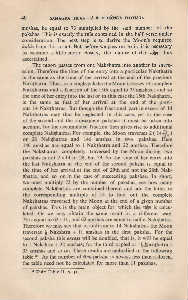Page 688 - Lokmanya Tilak Samagra (khand 2)
P. 688
40 SAMAGRA TILAK- 2 • VEDANGA JYOTI~HA
amshas, be equal to 73 multiplied by the said number of the
pakshas. This is exactly the rule contained in the half verse under
consideration. The next step is to derive the Moon's required
kalas from this result. But before we pass on to it, it is necessary
to examine a little more closely, the nature of the +l~lf thus
a certained.
The moon passes from one Nak~hatra into another in succe-
s ion. Therefore the time of the entry into a particular ak!Jhatra
is the same as the time of her arrival at the end of the previous
ak!Jhatra. Thus, in a single paksha the Moon trave e 14 complete
ak!Jhatras and a fraction of the 15th equal to 73 amshas,; and o
the time of her entry into the last or in this ca e the 15th Nak~hatra,
is the arne as that of her arrival at the end of the previ-
ou 14 Nak!Jhatras. But though the fractional part in excess of 14
Nak~batras may thus be neglected in thi case, yet in the case
of the econd and the sub equent pak has it mu t be taken into
account, for the accumulated fraction then give ri e to additional
complete Nak~hatra . Fore ample the Moon traverse 2 ( 14~; )
4
or 28 ak!!hatras and 146 amshas in two pakshas. Here
146 amshas are equal to l ak~hatra and 22 amshas. Therefore
the Nak~hatras completely traversed by the Moon during two
pak has i not 2 x 14 or 28 but 29. So the time of her entry into
the last ak~hatra at the end of the second paksha is equal to
the time of her arrival at the end of 29th and not the 28th ak-
!Jhatra; and so on in the case of succeeding paksha . In short
we must multiply 73 by the number of pakshas see how many
complete ak~hatra are contained therein and add the latter to
the corresponding multiple of 14 to find out the complete
ak~hatra traversed by the Moon at the end of a given number
of paksha . Thi i the main object for which the +l~ is calcu-
lated. Or we may obtain the same result in a different way.
73 is equal to 62 + 11 · and 62 amshas are equal to half a ak~hatra.
Therefore we may say that in addition to 14 ak~hatras the Moon
traver es i Nakshtra + 11 amshas in the first paksha. For the
second paksha this excess will be doubled that is, it will be equal
to 1 akshtra + 22 amshas; for the third tripled or I. ak!Jbatra +
33 am has and so on. These results are embodied in the following
table.* As the number of una-paksha is always less than a dozen,
the table need not be calculated for more than 11 pakshas.
• Vide Table II, p. 41.

